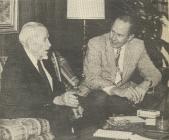In the late 1920s, a group of about 20 Georgia Tech professors started a research club. Each professor was a member of the scientific research society, Sigma Xi. In their monthly meetings, they discussed the latest technical papers and scientific breakthroughs.
One of the group's leaders was Harry Vaughan, associate professor of ceramic engineering. A 1923 graduate of Georgia Tech, Vaughan held a degree in engineering chemistry. He earned a master's from the University of Illinois. Like most Georgia Tech professors of the time, he did not hold a doctorate.
An Idea is Born
Vaughan added Georgia Tech issues to the research club's discussion topics, including the possibility of organizing an engineering experiment station on campus. In December 1929, Vaughan and fellow club members, Montgomery Knight and Harold A. Bunger, outlined how such an operation could be established.
"I proposed an engineering experiment station to President [Marion L.] Brittain in 1929," Vaughan said in a 1984 interview. "While studying the Georgia Code to see how one might be implemented, to my surprise, I found the EES had been authorized by the Georgia legislature in 1919."
No action was taken on the proposal. Nearly five years later, the idea resurfaced with the decisive support of the University System chancellor, Philip Weltner, and the president of the University of Georgia, S. V. Sanford.
Vaughan was named director when the State Engineering Experiment Station opened in 1934. "We were established as a separate unit of the University System, reporting directly to the chancellor, not as a department of Georgia Tech," he stated.
His office was located in the Aerospace Building, and "Mechanical Engineering rented us the tools for our experiments." The EES was housed in the basement of the Old Shop Building, just west of the Tech Tower.
The Early Years
"The Guggenheim Foundation gave $6,000 for aeronautical research, and the Textile Foundation also supported us," Vaughan recalled. "We developed cotton roving and spinning processes that were three to five times as fast those that were current in the industry."
EES found a new home when the Research Building was constructed in 1939. Vaughan is credited with designing the structure. Several years later, it was expanded and renamed the Thomas Hinman Research Building. Also in 1939, Vaughan took on additional responsibilities as director of the School of Ceramic Engineering, raising his annual salary to $4,200.
Vaughan resigned from his Georgia Tech positions in 1940 to accept the job as chief of the Regional Products Research Division of the Tennessee Valley Authority.
For more, visit the Wikipedia article on W. Harry Vaughan.

